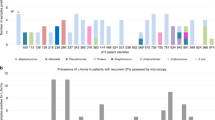Summary
All 45 microscopically motile urinary isolates tested here (37Escherichia coli, twoEnterobacter cloacae, twoCitrobacter freundii, threeProteus mirabilis and oneProteus morganii) were strongly attracted to fresh human urine in a capillary chemotaxis assay. This observation suggested that urine taxis of gram-negative bacteria promotes their invasion of the human lower urinary tract and their ascension to the kidney(s). However, the incidence of motile isolates and their activity in urine taxis assays were similar for fecalE. coli isolates, for isolates from patients with recurrent cystitis and from patients with presumed pyelonephritis (E. coli blood isolates with concomitantE. coli bacteriuria). Thus, the present study ofE. coli did not support the hypothesis that bacterial motility is a virulence factor in urinary tract infection.
Zusammenfassung
Alle untersuchten 45 Isolate aus Urin, die mikroskopisch Motilität aufwiesen (37Escherichia coli, zweiEnterobacter cloacae, zweiCitrobacter freundii, dreiProteus mirabilis und einProteus morganii) wurden in einem Kapillar-Chemotaxistest von frischem menschlichem Urin stark angezogen. Aus dieser Beobachtung war zu schließen, daß die Taxis gramnegativer Bakterien durch Urin die Invasion dieser Keime in die unteren Harnwege und das Aufsteigen in die Niere(n) begünstigt. Jedoch war die Inzidenz beweglicher Isolate und ihre Aktivität in Taxisversuchen mit Urin bei Isolaten vonE. coli aus dem Stuhl, Isolaten von Patienten mit rezidivierender Cystitis und von Patienten mit vermuteter Pyelonephritis (E. coli-Isolate aus Blut bei gleichzeitigerE. coli-Bakteriurie) ähnlich. Somit war die Hypothese, daß bakterielle Motilität einen Virulenzfaktor für die Harnwegsinfektion darstellt, durch die vorliegende Untersuchung nicht zu stützen.
Similar content being viewed by others
Literature
Stamey, T. A. Pathogenesis and treatment of urinary tract infection. Williams & Wilkins, Baltimore/London 1980.
Svanborg Edén, C., Hanson, L. Å., Jodal, U., Lindberg, U., Sohl-Åkerlund, A. Variable adherence to normal human urinary tract epithelial cells ofEscherichia coli strains associated with various forms of urinary tract infection. Lancet II (1976) 490–492.
Källenius, G., Svenson, S. B., Hultberg, H., Möllby, R., Helin, I., Cedergren, B., Winberg, J. Occurrence of p-fimbriatedEscherichia coli in urinary tract infection. Lancet II (1982) 1369–1372.
Engelmann, T. W. Zur Biologie der Schizomyceten. Pflüger's Arch. Ges. Physiol. 26 (1881) 537–545.
Pfeffer, W. Über Chemotaktische Bewegungen von Bacterien, Flagellaten und Volvocineen. Untersuch. Bot. Inst. Tübingen 2 (1888) 582–661.
Tso, W.-W., Adler, J. Negative chemotaxis inEscherichia coli. J. Bacteriol. 118 (1974) 560–576.
Goy, M. F., Springer, M. S. In search of the linkage between receptor and response: the role of a protein methylation reaction in bacterial chemotaxis. In:Hazelbauer, G. L. (ed.): Taxis and behaviour. Elementary sensory systems in biology. Receptors and recognition. Series B Vol 5, Chapman and Hall, London 1978, p. 769.
Hazelbauer, G. L. Bacterial chemotaxis: Molecular biology of a sensory system. Endeavour, New Series. 4 (1980) 67–73.
Herrmann, B., Burman, L. G. Chemoattracting effect of human urine on motileEscherichia coli, FEMS Microbiol. Lett. 20 (1983) 411–415.
van der Waaij, D., Speltie, T. M., Vossen, J. M. Biotyping ofEnterobacteriaceae as a test for the evaluation of isolation systems. J. Hyg. 70 (1972) 639–650.
Adler, J. A method for measuring chemotaxis and use of the method to determine optimum conditions for chemotaxis byEscherichia coli. J. Gen. Microbiol. 74 (1973) 77–91.
Bertani, G. Studies on lysogenesis. I. The mode of phage liberation by lysogenicEscherichia coli. J. Bacteriol. 62 (1951) 293–300.
Burman, L. G., Östensson, R. Time and media-saving testing and identification of microorganisms by multipoint inoculation on undivided agar plates. J. Clin. Microbiol. 8 (1978) 219–227.
Freter, R., Allweiss, B., O'Brien, P. C. M., Halstead, S. H., Macsai, M. S. Role of chemotaxis in the association of motile bacteria with intestinal mucosa:in vitro studies. Infect. Immun. 34 (1981) 241–249.
Freter, R., O'Brien, P. C. M., Macsai, M. S. Role of chemotaxis in the association of motile bacteria with intestinal mucosa:in vivo studies. Infect. Immun. 34 (1981) 234–240.
Author information
Authors and Affiliations
Rights and permissions
About this article
Cite this article
Herrmann, B., Burman, L.G. Pathogenesis of escherichia coli cystitis and pyelonephritis: Apparent lack of significance of bacterial motility and chemotaxis towards human urine. Infection 13, 4–7 (1985). https://doi.org/10.1007/BF01643612
Received:
Accepted:
Issue Date:
DOI: https://doi.org/10.1007/BF01643612




